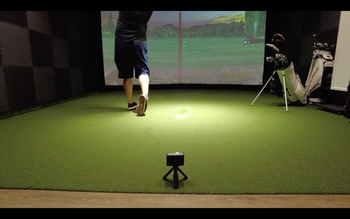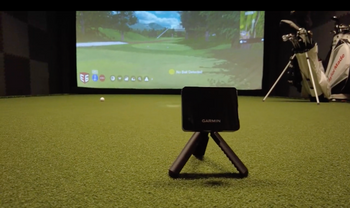You've probably spotted those sleek launch monitors next to tour pros at driving ranges or caught a glimpse during tournament broadcasts. That's the Foresight Sports GCQuad, and it's quickly becoming the go-to device for players who want rock-solid data about their swing.
Here's what makes this thing special for your home setup. While most launch monitors need to sit several feet behind you (eating up precious garage or basement space), the GCQuad parks itself right beside the ball. You're looking at saving 6-8 feet of room length – that's huge when you're trying to squeeze a simulator into your house.
The accuracy is what sets this unit apart from cheaper options. We're talking tour-level precision on every shot metric you can imagine – ball speed, launch angle, spin rate, club path, face angle at impact. It uses four high-speed cameras to capture exactly what's happening at the moment of truth. Think of it as having a team of swing coaches analyzing every millisecond of impact.
Setting it up is surprisingly straightforward. Place it about 18 inches to the side of your ball position, align it properly, and you're good to go. The device tracks both your club and ball data without needing special stickers or marked balls like some competitors require.
For a 15-handicapper looking to drop strokes, this data becomes your roadmap. Maybe you discover your 7-iron spin rate is way too high, robbing you of distance. Or perhaps your driver face is consistently open at impact, explaining those weak fades. The GCQuad shows you exactly what's happening versus what you think is happening.
The indoor experience rivals any high-end facility. When paired with quality simulator software, you're getting the same feedback that tour pros use to dial in their games. Practice sessions become more productive because you're not guessing anymore – you know precisely why that shot curved or came up short.
Let's be real about the investment, though. At several thousand dollars, this isn't an impulse buy. You could play a lot of rounds for that price. But if you're serious about improvement and plan to use it regularly, the cost per practice session drops quickly. Plus, no more range fees or weather delays.
The main limitation? You'll need decent ceiling height (minimum 9 feet) and enough width for a full swing. Also, while the unit itself saves space front-to-back, you still need room for a hitting mat, screen, and projector if you want the full simulator experience.
Bottom line: If you're committed to taking your game to the next level and have the space and budget, the GCQuad delivers professional-grade feedback that actually translates to lower scores. It's like having a tour-level practice facility in your home, minus the crowds and tee time hassles.
Table of Contents
Key Features
Minimal Space Requirements: The GCQuad requires significantly less space than traditional radar-based launch monitors because it sits to the side of the golf ball rather than behind it. The absolute minimum space needed is 12 feet long by 10 feet wide and 9 feet high, though this provides just enough room for a comfortable swing.
Optimal Room Dimensions: For the best experience, rooms should be 18 feet long, 15 feet wide, and 10 feet high. These dimensions allow for comfortable swinging, proper aim alignment, and help minimize issues like bounceback and indoor swing syndrome that can occur in cramped spaces.
Precise Positioning Requirements: The GCQuad unit sits exactly 22 inches from the center of a designated hitting area that measures 14 inches long by 14-18 inches wide. This specific positioning ensures optimal data capture from its four high-speed cameras operating at 6,000 frames per second.
Foresight GCQuad Golf Launch Monitor
The undisputed king of golf launch monitors, the GCQuad delivers unmatched precision with exclusive Quadrascopic imaging technology for ultimate performance.
Optimal Room Dimensions for Setting Up Your GCQuad Golf Simulator
You know what's crazy? Most golfers think they need a warehouse-sized room for a home golf simulator. But here's the deal - it really depends on what kind of launch monitor you're using.
So you've got three basic ways these launch monitors work. Some sit right beside your ball on the ground. Others mount up on the ceiling behind where you're hitting from. And then there's the type that sits on the floor several feet back from your setup.
That first option - the one that sits next to your ball? That's your space-saver right there.
See, those radar units that sit behind you on the floor? They're hungry for space. You're looking at needing them positioned 6 to 8 feet back from your ball, plus another 8 to 13 feet between where you're hitting and your screen. Why all that room? The radar has to track your ball spinning through the air to figure out things like how much backspin you've got and whether you're hitting that dreaded slice.
The ceiling-mounted ones? Same story. They need tons of depth to get accurate readings on your shots.
Now here's where it gets interesting. Photometric launch monitors - think of them as super-smart cameras - work totally differently. Take the GCQuad, for instance. This bad boy uses four high-speed cameras that capture everything right at impact. It's watching from the side, not from behind, so you don't need a bowling alley's worth of space.
Want the bare minimum for a GCQuad setup? You're looking at:
- 10 feet of width
- 10 feet of depth
- 9 feet of height
That's it. Seriously. Just enough room to take a full swing without smacking the walls and enough distance so the ball doesn't bounce back and nail you in the shins.
Now, I'll be straight with you - those are the minimum numbers. If you're dropping serious cash on something as nice as a GCQuad, you might want to go bigger on your simulator bay. Golfers Authority has some sweet complete packages that come in 10, 12, or 13-foot widths. Sure, the 10-footer works, but man, that 13-foot setup gives you a way more immersive experience with a bigger screen to watch your shots.
And about that ceiling height, 9 feet works for most of us weekend warriors. But if you're one of those guys who takes it back like John Daly, or you're just tall with a big swing arc, you might need to go higher.
Here's the thing, though - and this is important - while the GCQuad saves you a ton of space compared to radar units, it does have one limitation you need to know about...
Note: The text appears to be cut off at this point, as the original ends with a mention of a key limitation without explaining what it is.

Limitations to Consider with the Compact GCQuad Launch Monitor
You know that space-saving setup the GCQuad offers by sitting next to the ball instead of behind it? Well, here's something that might throw a wrench in your plans if you're setting up a home simulator.
Picture this: You're crushing drives with your buddies, taking turns on the sim. Everything's flowing great until your left-handed friend steps up. Now you've gotta stop everything, walk over, and drag that launch monitor to the other side. Not exactly keeping the good vibes rolling when you're trying to play a quick 18.
The beauty of rear-mounted launch monitors is that they don't care which side of the ball you're standing on. Whether you're a righty or your southpaw buddy wants to take a swing, the unit stays put and keeps tracking shots without missing a beat.
Don't get me wrong - the GCQuad's accuracy is off the charts, and being able to squeeze a simulator into a tighter space is huge. That side-positioning means you don't need a massive room stretching way back from the hitting area.
But here's what you gotta think about: Who's gonna be using your setup? If it's just you and your regular foursome of right-handers, you're golden. The GCQuad will treat you right. However, if you've got that one lefty in your crew (we all know that guy), constantly shuffling equipment around gets old fast.
There's always another option to consider - something like the Foresight Sports Falcon that mounts behind you. Sure, you'll need more room depth, but nobody's doing the launch monitor shuffle between shots. Sometimes the convenience factor wins out over saving a few feet of space.
Foresight GCQuad Golf Launch Monitor
The undisputed king of golf launch monitors, the GCQuad delivers unmatched precision with exclusive Quadrascopic imaging technology for ultimate performance.
Is the Foresight GCQuad Golf Launch Monitor & Simulator Worth It?
Absolutely, while the Foresight GCQuad Golf Launch Monitor & Simulator is a great product, there are a few pros and cons that you need to be aware of:
Pros:
Space-Efficient Design: The GCQuad’s side-mounted, photometric technology requires significantly less room depth than radar-based systems, making it ideal for home setups with limited space.
Professional-Grade Accuracy: Trusted by PGA Tour professionals, the GCQuad delivers unmatched precision in ball and club data, ensuring a realistic and reliable simulator experience.
Quick and Easy Setup: The unit is portable and can be set up in under a minute, with no complex calibration or alignment needed, saving time and hassle.
Cons:
Premium Price: The GCQuad is one of the most expensive launch monitors on the market, making it a substantial investment for most home users.
Righty/Lefty Limitation: Switching between right-handed and left-handed players requires physically moving the unit, which can disrupt the flow of play and is less convenient compared to fixed-position systems.
Club Sticker Requirement: Accessing advanced club data necessitates applying and maintaining stickers on each club, which can be inconvenient and add to the ongoing cost and setup effort.
Frequently Asked Questions
What are the minimum space requirements for a GCQuad home golf simulator setup?
The minimum recommended room dimensions are 10 feet wide, 10 feet deep, and 9 feet tall. These measurements allow most golfers to swing comfortably and use the GCQuad effectively.
What are the ideal room dimensions for the best GCQuad simulator experience?
For a more comfortable and premium experience, a room measuring 18 feet long, 15 feet wide, and 10 feet high is ideal. This provides ample space for full swings, centered aim, and reduces the risk of bounceback.
Can I use the GCQuad in a smaller room than the minimum recommendations?
While it is technically possible to use the GCQuad in slightly smaller spaces, doing so may limit your swing and overall experience. It's crucial to have enough room to swing your longest club safely without fear of hitting walls or the ceiling.
Does ceiling height matter for the GCQuad simulator?
Yes, ceiling height is important. A minimum of 9 feet is recommended, but taller golfers or those with longer swings may require higher ceilings to avoid contact during the swing.
How much width do I need for a centered aim and realistic play?
To achieve a centered aim—where your ball and target line are aligned with the center of the impact screen—15 feet of room width is recommended. Narrower rooms may force you to offset your aim, which can be less realistic and visually distracting.
Evaluating the GCQuad: Is It the Right Choice for Your Home Golf Simulator?
You're basically looking at the Cadillac of launch monitors when you check out the Foresight Sports GCQuad. This thing's so precise that tour pros rely on it daily - imagine having that same tech reading your shots in your garage.
What makes it special? The GCQuad nails every little detail about your ball flight. We're talking exact spin rates, true-to-life ball curves, and distances that match what you'd see on the course. Those cheaper launch monitors? They get close, sure, but they'll fudge your numbers just enough to mess with your head when you hit real balls outside.
Here's the deal - when you grab a GCQuad, you're getting three different simulator software options included: FSX Play, FSX 2020, and FSX Pro. Each one delivers graphics so crisp you'll forget you're indoors. Plus, they throw in 25 courses ready to play, so you won't be stuck hitting into the same virtual range every session.
The way it captures data is wild. Four high-speed cameras track both your club and ball simultaneously, which means it catches everything - even those sneaky heel strikes you swear didn't happen. That quad-camera setup is why your 7-iron that normally fades 5 yards will fade exactly 5 yards on screen, too.
Now, here's something to consider before you pull the trigger. If you've got both righties and lefties in your crew, you'll need to physically move and recalibrate the unit between players. It's not a deal-breaker, but it'll slow down your buddy golf nights a bit.
Bottom line? If you want simulator golf that feels exactly like the real thing and you've got the budget for it, the GCQuad delivers. Your practice sessions will actually translate to the course because you're getting legitimate feedback on every swing.






